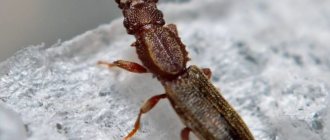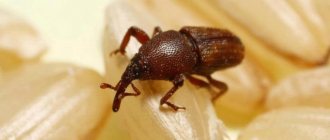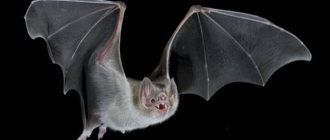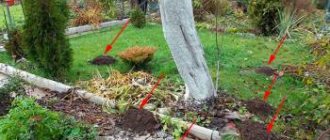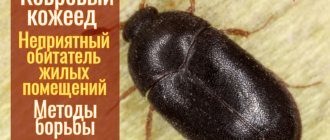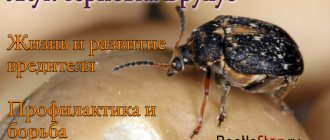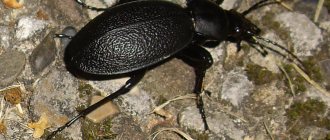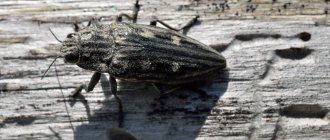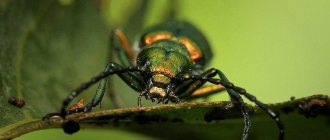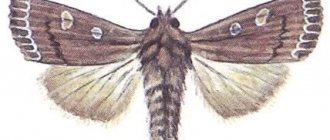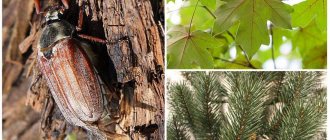Pretense beetles are a family of beetles very similar in lifestyle and appearance to grinders. It has 450 species, of which 27 are considered pests. They often live near humans and damage grain and other food products. Pretenders have a more rounded body and longer antennae and limbs than grinders. Among the most common types of pests are the thief pretender and the hairy pretender. Adults and larvae of insects are polyphagous. Under natural conditions, they are found on plant debris, in rodent burrows and bird nests.
Appearance and behavior of Ptinus fur
The trickster thief is a beetle that looks like a spider. This specimen of the insect family gets its name due to its ability to appear dead. In case of any danger, he tucks his mustache and quotes under the body, falling from the object where he was located. Also, this insect cannot boast of large sizes: the male is 4.3 mm, while the female is 3.1 mm. Sexual dimorphism can be found due to differences in color and body type.
The male has a large body length, his abdomen is shaped like a cylinder. The color is predominantly uniform - red or brown. The whiskers are large and 0.5 millimeters thick and can reach 2 millimeters. The eyes are large and protruding, located on opposite sides of the head. The elytra have longitudinal rows of dots. The hind wings are well and strongly developed for their size, thanks to which males can fly short distances.
The body of the female individual is spherical in shape, predominantly brown and black in color. The pronotum is divided in the middle by a deep groove along its entire length, at the edges of which there are small tubercles with small hard hairs. The mustache is much smaller than that of a man's face. The elytra also have dotted markings and are rounded at the rear. The wings are somewhat shortened, the limbs are brown in color.
Structure
An adult beetle reaches a length of 2.5 - 7.0 mm, chocolate brown in color, but there are lighter and darker individuals covered with short golden hairs, but a magnifying glass is needed to see them. The head is not visible from above, as it is hidden by a hood with a high hump. Metathorax and first abdominal sternite without recesses for insertion of legs. The antennae are thread-like.
Stages of development
“Thieves” live in rotten plant debris, dead wood, rodent burrows and bird nests. In warehouses they live in the upper layer of the food embankment, in the lining of the walls. Only mature individuals and larvae overwinter. Pupation occurs in cocoons, which are prepared on the basis of food materials. Development from egg to adult form under favorable conditions lasts 100-120 days. It produces up to three generations per year, depending on external conditions.
Three stages of pest development are known:
- Larva crawling out of eggs. She is easily recognized due to the lack of chitin, limbs and light body color
- Doll. Unlike the previous stage, it already has quotes, but is still not protected, and is also covered with light-colored skin.
- An adult, mature face. They already have developed wings and chitin. Sexual dimorphism occurs primarily in size because males are larger than females.
How to detect a pest?
To detect a pest, you need to check all wooden products in your home. A characteristic sign that the grinder has started is small round holes-movements or wormholes in the wood. If there are many wormholes and they are very deep, then such wood must be burned, otherwise in two or three years there will be nothing left of it. In other cases, the wood is treated with special means.
Reproduction
This type of insect is characterized by a nocturnal lifestyle; during daylight hours it waits in dark places. In the wild and indoors without a heating system, one generation grows per year. Human activity has greatly facilitated the process of obtaining food and provided the opportunity to reproduce in comfort. Beetles love warmth, the optimal temperature for them is 20-25°. The lifespan of the imago is regulated solely by the temperature around it. With excessive heat, all life processes, such as metabolism, are accelerated by 2-3 times. The offspring grow rapidly, while the life cycle shortens accordingly.
Lifestyle, nutrition
The adult lives in trees and feeds on leaves. Prefers poplar, clear, maple. It often grows on lilacs, olives, and forest crops. Beetles fly actively from May to August in sunny weather. At night, they sit motionless on trees, clinging to the leaves with strong paws.
Spanish fly beetle
The mating season begins at the end of May. The female descends under the roots of the trees and lays eggs in the soil in groups of 50 pieces. Over the entire warm season, one female reproduces 1000 larvae. The embryos develop for several days, then small black larvae - caterpillars - appear. They sneak into the nests of earth wasps and bumblebees, destroying reserves of nectar, honey, and offspring.
Signs of appearance
Mass appearance of beetles is observed in April and October. The most favorable temperature for their development is 23 ° C. In the hive, beetles and larvae feed on the corpses of bees that died with brood, wax and beebread; they damage the walls of the hive and insulation. In warehouses, insects damage honeycombs, eat beebread and wax, the cells of the honeycombs are filled with a layer of powdery mass, under which holes are visible. Upon careful examination of these holes, similar to the passages made by the small wax moth, a real pest is identified by the absence of cobweb threads and feces.
Maliciousness
Polyphagous insects settle in granaries, food warehouses, museums, residential buildings, confectionery and pasta factories.
When feeding and reproducing, they damage:
- cereals and grains;
- entomological and botanical collections;
- upholstered furniture;
- book bindings;
- plants' seeds;
- meat, sausages;
- fur, leather, woolen fabrics.
Information. Larvae of the species Ptinusfur are a real disaster for herbariums. They litter collections with waste in powder form.
The pretend thief is a pest of bee hives. When insects enter the apiary, they feed on insulating fabrics and felt, beebread, and dead brood. Beetles damage the honeycombs and walls of the hive. Their presence is revealed by the appearance of crumbs and noticeable passages. As a preventative measure, it is recommended to dry the insulation and keep the hive clean.
Preparations against the fake beetle and other control and prevention measures
- To control and prevent harmful insects of this family, the following methods are most often used:
- To kill the beetle, the affected grain is first heated, then cooled and finally cleaned.
- The use of chemical control agents evenly distributed over the storage area shows itself to be beneficial. For this purpose, contact insecticides are used, such as DEFENDA Fumigant. It helps to get rid of the deceiver and is safe for humans. The consumption rate of the working solution is 2-3 tables. (6-9 g)/1 t or 1 m3.
- To prevent infection, clean and disinfect premises.
- Only dry grain should be placed in storage granaries.
From household storerooms
You can spray cabbage with infusions of tomato tops
- Pollination gives good results. You can use tobacco waste and ash in a 1:1 ratio. Dry lime is also suitable for these purposes. It will require 10 g per square meter of area.
- Don't forget about regular table vinegar (9%). A 0.5 liter bottle of a diluted aqueous solution of acetic acid is diluted in 10 liters of water. Spraying should be carried out in the evening and in calm weather so that the substance does not quickly dry out and evaporate.
- Prepare lime milk from fluff. First, pour a bucket of water into 2 kg of hydrated lime and add wood glue (50 g) for better adhesion of the solution to the plant. The composition is sprayed onto the plants before the beetles appear.
- Effective folk remedies made from potato or tomato tops and garlic. Take 200 g of finely crushed garlic, the same amount of chopped tops, 50 g of liquid soap and a bucket of water. All components are mixed well. Let it brew for 4-5 hours and treat the affected plants.
- The same tomato tops are used in a different way. Tomato seedlings are planted. The removed shoots are not thrown away, but are filled with 4 kg of water (10 l). Let the mixture sit for 5 hours. Then it simmers over low heat for another 2 hours. The strained and cooled infusion is diluted halfway with water before application. 40 g of soap is first added to it.
- You can infuse chamomile. Pour 1 kg of flowers (dried) with water (10-15 l). Half a day is enough for the chamomile to infuse. Then strain and add another 20 liters of water. Add soap (80 g) to the finished concentrate.
- The smell of calendula, yarrow and wormwood repels the leaf beetle. They are planted around the site or infusions of these herbs are prepared.
- You can ward off the bug by daily morning pollination of horseradish and cabbage seedlings with tobacco dust. It is mixed with sifted furnace ash in equal proportions. Ash can be replaced with lime. To maximize the adhesion effect of the composition, it should be applied to the plant in the early morning dew. The composition has a repellent effect. It is consumed approximately 30 g per square meter of processing area.
Many drugs and infusions have a wide spectrum of action, destroying other pests. In order not to resort to pesticides, you need to take seriously the prevention of pests on garden crops.
Insecticides for mealy beetle
The use of insecticidal preparations in the habitats of the pest, the beetleworm, may be associated with a problem associated with the danger of chemicals getting into food products. In nature, the natural habitat of this agricultural pest, it is controlled using the following types of insecticides:
- fumigation preparations based on phosphine - hydrogen phosphorous;
- contact agents used to spray grain - solutions are produced in the form of concentrated emulsions;
- means for aeration using fog generators;
- insectoacaricides based on pirimophos, bifenthrin and other pyrethoid drugs.
Chemical insecticides for home use are also based on substances of the pyrethoid group. Organophosphorus compounds are not used here due to their high toxicity. Preparations for home use are mainly used in the form of gels or aerosols for topical spraying.
Sanepidemstation.com in the fight against Khrushchak
Pests that have the ability to cause significant inconvenience to humans - flour beetles - can easily be destroyed as soon as possible if you take care to seek the help of professionals. The specialists of Sanepidemstation.com are ready to offer their services for the quick and effective treatment of warehouse, commercial, and residential premises from pests using modern equipment. Spraying drugs using fog generators involves the use of highly efficient technologies.
The visit of specialists allows you to achieve maximum effect in pest control and gives pronounced results within the first few days after the treatment. The cost of treating apartments and houses with insecticidal agents against flour beetles depends on the area of the objects. Chemicals are sprayed under high pressure, creating fine dust that penetrates into the most inaccessible corners of the space.
Help from professionals
It is important to understand that severe infestation of premises by pests requires exclusively professional treatment, preferably using hot fog generators that combine thermal and chemical effects. Specialists are ready to offer their clients enormous experience in treating pests of both small residential spaces and in protecting warehouses, museums, and retail areas
After just one visit from specialists, you can easily get rid of any sources of danger, stop the invasion of adult bugs or their larvae, and also prevent their reappearance. The main thing is not to waste time and immediately contact professionals when a problem is discovered.
